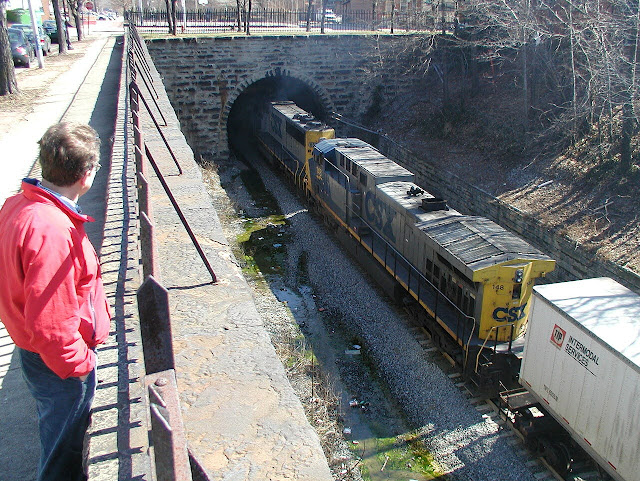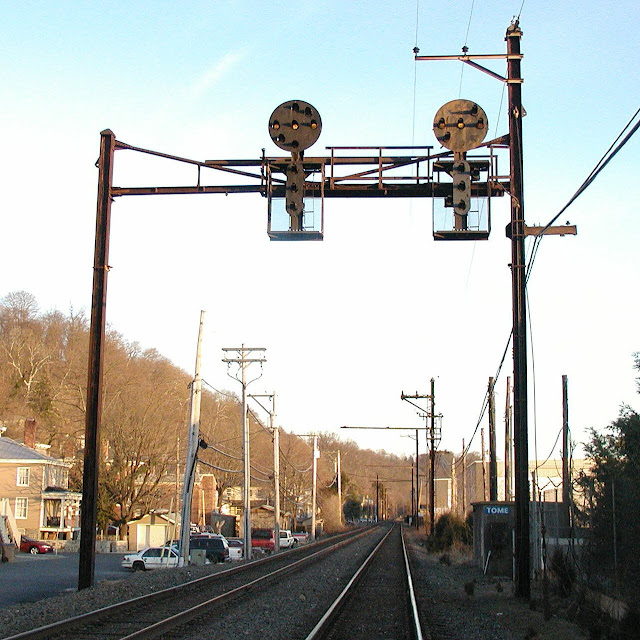In early 2004 I was living in Baltimore City just a half block from the Baltimore Belt Line, famous for its role in main line railroad electrification in the 1890's, which provided me with a convenient opportunity to photograph CSX freight action on its North-South service lane between Florida and New York. Although my interest flagged over the years, back in 2004 I was still willing to leave the scanner on in my apartment and then rush out the door when I heard indication of an approaching train movement. While at the time I didn't have much appreciation for the freight power that was passing by, little did I know that it would only get more dull as the years went on and I had actually photographed some interesting power. You can view the full gallery here ( mirror ).
First up is CSX C44-9W #9035. This was one of 53 C44-9W's delivered to CSX in 1993/94 and actually served as something of a transition between the GE -8 and -9 offerings as these were equipped with the wavy C40-8 trucks.
Trailing #9035 was SD40-2 #8445, also in the now rare YN2 paint scheme.
Eastbound trains would need to give it their all to ascend the grade up from the Baltimore waterfront to the level of the inland plateau. This is evidenced by the diesel exhaust smoke pouring from the Charles St tunnel after passage of the head end power.
Here we have a light engine move with AC4400 #524 drifting westbound through the cut between Charles and Saint Paul Streets. Not sure if these were returning from a helper job, but such movements were not that uncommon. In 2014 the 1890's stone retaining wall at the left of this photo would collapse after 4 straight days of rain undermined its structural integrity.
Here Conrail SD60I #8763 leads a westbound train down the grade. A Conrail exclusive, these late model SD60's would eventually be retired by CSX and NS in the 2010's.
Emerging from a cloud of its own exhaust smoke, brand new CSX SD70MAC #4727 leads an eastbound train up the grade. #4727 was part of a final batch of 130 tier 1 rated SD70MACs that were purchased in the 2004 time frame. They could be told apart from early SD70MACs via the use of flared radiators that allowed for the intercooler to have a separate cooling loop. Behind #4727 we can see the cab of AC4400 #521.
Back in the 2000's lease units seemed to be much more popular with HLCX SD40-2 #6524 running behind #521.
Some of the loads in this train were granite blocks that may have been destined for the World Trade Center site in New York.
The next westbound train featured a brand new CSX SD70MAC #4709 followed by a decidedly less new CSX GP40-2 #6118.
The next westbound had a fair of narrow cab EMD power in the form of CSX SD40-2 #8575 and Conrail SD50 #8664.
The next eastbound I caught was led by C40-8W #7813, which would be still active in 2021, and transitional C44-9W #9041.
A southbound train of municipal waste from New York City en route to landfills in the south drifts down the grade with CSX GP40-2 #6248 in the lead and a lease unit behind. For whatever reason the GP40-2 was very popular with the B&O railroad, who purchased 218 examples, twice as many as the far larger Conrail system at the time.
A big surprise in my reprocessing effort was finding a photo of #5007, a 6000hp AC6000 super-power diesel that looks pretty much like every other bit of GE power from the front. At the back however its true nature is exposed by the twin exhaust stacks and extra long radiator. This unit would later be rebuilt with a 4600hp GE EVO powertrain.
Following #5007 was HLCX lease SD40-2 BN #7002.
That's not the only AC6000 I'd see in this time period either as a few days later I managed to catch the last CSX unit purchased, #5016, sandwitching CSX SD40-2 #8573 with AC4400 #148. The AC4400 fleet was and is the true backbone of CSX with over 600 examples purchased around the year 2000.
Leaving Baltimore, here is a quick photo of some old PRR signal locations on the Port Road north of Port Deposit at CP-TOME and the Milepost 6.4 automatic. Note that despite the electrification being taken out of service in 1981, the 6.9kv 100hz signal power line from 1937 was still in service and would remain so until about 2010 when NS transitioned the signals to utility power and scrapped most of the old catenary poles. Note the yellow PCB warning square on the transformer in the first photo.
That's all I have for now. Catch you later.





















No comments:
Post a Comment